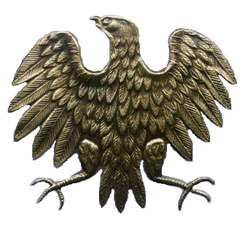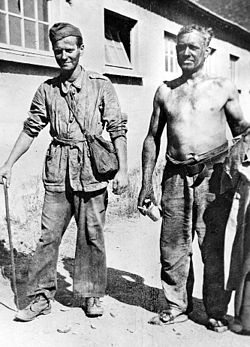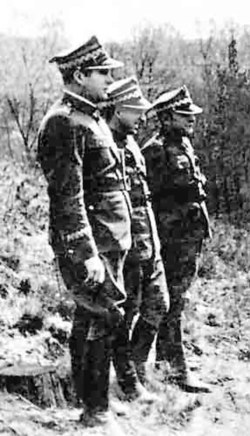- This article is about the World War II period. For World War I, see Polish Armed Forces in the East (WWI).
 The "Piast eagle" (specimen 43) worn by Polish Army Formations in the East, 1943-1945  Polish volunteers to the Anders Army, released from a Soviet POW camp Soldiers of the Polish Second Army in the area of Nysa Łuzycka River after fording it in April 1945  Karol Świerczewski (front). The two other officers are Marian Spychalski and Michał Rola-Żymierski. |
Polish Armed Forces in the East (Polish language: Polskie Siły Zbrojne na Wschodzie ) (or Polish Army in USSR) refers to military units composed of Poles created in the Soviet Union at the time when the territory of Poland was occupied by both Nazi Germany and the Soviet Union in the Second World War. Broadly speaking, there were two such formations. The first was the Polish government-in-exile-loyal Anders Army, created in the second half of 1941 after the German invasion of the USSR led to the 30 July 1941 Polish-Soviet Sikorski-Mayski Agreement declaring an amnesty for Polish citizens held captive in the USSR. In 1942 this formation was evacuated to Persia and transferred to the Western Allies, whereupon it became known as the Polish II Corps and went on to fight Nazi German forces in Italy, including at the Battle of Monte Cassino. Following this, the remaining Polish forces in USSR were reorganised into a Soviet-controlled Polish I Corps in the Soviet Union, which in turn was reorganised in 1944 into the Polish First Army (Berling Army) and Polish Second Army, both part of the Polish People's Army (Ludowe Wojsko Polskie, LWP). In 1944, the Polish People's Army was reorganised to become the military of the communist-ruled People's Republic of Poland.
Anders Army: 1941-1942[]
After the German occupation of the eastern part of interwar Poland by that time effectively defeated by the German invasion, the Soviets effectively broke off diplomatic relations with the evacuated Polish government.[1] Diplomatic relations were however re-established in 1941 after the German invasion of the Soviet Union forced Soviet premier Joseph Stalin to look for allies. Thus the military agreement of August 14 and subsequent Sikorski-Maiski Agreement of August 17, 1941, resulted in Stalin agreeing to declare the Molotov-Ribbentrop Pact in relation to Poland null and void,[2] and release tens of thousands of Polish prisoners-of-war held in Soviet camps. Pursuant to an agreement between the Polish government-in-exile and Stalin, the Soviets granted "amnesty" to many Polish citizens, from whom a military force was formed. General Władysław Sikorski, the leader of the London-based exiled government of Poland, nominated General Władysław Anders - one of the Polish officers held captive in the Soviet Union - as commander of this new formation. The formation began to organise in the Buzuluk area, and recruitment begun in the NKVD camps for Polish POWs. By the end of 1941 25,000 soldiers (including 1,000 officers) had been recruited, forming three infantry divisions: 5th, 6th and 7th. In the spring of 1942 the organising formation was moved to the area of Tashkent; the 8th and 9th divisions were also formed that year.[3]
In the second part of 1942, during the German Caucasus offensive (the most notable part of which was the Battle of Stalingrad), Stalin agreed to use the Polish formation on the Middle Eastern front; and the unit was transferred via the Persian Corridor to Pahlevi, Iran. As such, the unit passed from Soviet control to that of the British government, and as the Polish Second Corps joined the Polish Armed Forces in the West. About 77,000 combatants and 41,000 civilians - former Polish citizens - left the USSR with the Anders Army.
Berling Army: 1943-1945[]
After the Anders Army left Soviet controlled territory, and it became more and more apparent that the Soviet forces were able to hold the front against the German invaders without reliance on Western aid (Lend-Lease Act) or temporary allies (like the Polish government-in-exile), the Soviets decided to assume much greater control over the remaining Polish military potential in the USSR (ignoring the agreements signed with the Polish government-in-exile). Increasing numbers of volunteers were denied the opportunity to enlist in the Polish formations, instead they were declared Soviet citizens and assigned to the Red Army. Activities of organisations and people loyal to the Polish government-in-exile, particularly the Polish embassy in Moscow, were curtailed and its assets confiscated. Finally, diplomatic relations between the Soviets and the Polish government-in-exile were severed again as news of the Katyn massacre emerged in 1943.[4]
In 1943 the Soviet Union created in Moscow the Union of Polish Patriots (ZPP) as a communist puppet government[5] designed to counter the legitimacy of the Polish government in exile; the ZPP was led by the pro-Soviet Polish communist Wanda Wasilewska.[6]
At the same time a new army was created - the Ludowe Wojsko Polskie (Polish People's Army, LWP). Its first unit, the 1 Polish Infantry Division (1 Dywizja Piechoty im. Tadeusza Kościuszki), was created in summer 1943, reaching operational readiness by June/July. In August, the Division was enlarged to a corps, becoming the Polish I Corps. It would be commanded by General Zygmunt Berling; other notable commanders included General Karol Świerczewski and Col. Włodzimierz Sokorski. The division with its supporting elements was sent to the Eastern Front in September 1943; one of the most notable battles of that period was the Battle of Lenino, the first major engagement of the Berling Army. By March 1944 the Corps had been strengthened with increasing armoured and mechanical support, and numbered over 30 000 soldiers. In mid-March 1944 the Corps was reorganized into the Polish First Army. The later Soviet-created Polish army units on the Eastern Front included the Second (1945) and the Third Polish Armies (the latter was quickly merged with the second due to recruitment problems), with the number of smaller formations being 10 infantry divisions (numbered from 1st to 10th[3]) and 5 armoured brigades. Plans for a Polish Front were considered but dropped, and the Polish First Army was integrated into the 1st Belorussian Front.
These units were led by Soviet commanders, appointed by the Soviets and fought under Soviet general command (the Second Army, for example, was led by the Soviet general Stanislav Poplavsky). In the Air Force of those formations 90% of officers and engineers were Soviet ones, the situation was similar in armoured formations. In the Polish Second Army they comprised 60% of officers and engineers, and in the 1st 40%. In the command staff and training the percentage of Soviets was about 70 to 85%. Special political officers, almost exclusively made up of Soviets, oversaw the Polish soldiers. The Soviets created also political military police, based on thousands of secret informants called Główny Zarząd Informacji Wojska Polskiego in Polish.[7]
The First Army entered Poland from Soviet territory in 1944. Under Soviet orders it did not advance into Warsaw as the Germans military defence of Warsaw was substantial with combined SS units fighting to the death against the advancing Polish units. (General Zygmunt Berling gave the command to move forward cross the Vistula river into Warsaw. During this episode of fighting against Nazis heavy losses were sustained by the First division while crossing the Vistula river into Warsaw yet it was pivotal in the eventual liberation of Warsaw from Nazi forces. In January 1945, after the Germans had unsuccessfully suppressed the uprising against Polish forces, the 1st Army participated in the Soviet Warsaw offensive that finally ended the Nazi occupation of the ruined city. In April–May 1945 the 1st Army fought in the final capture of Berlin.
See also[]
- Polish Armed Forces in the West
- Polish contribution to World War II
- History of Poland (1939-1945)
- Northern Group of Forces
- Soviet invasion of Poland
- History of Poland (1945–1989)
- Soviet repressions of Polish citizens (1939-1946)
References[]
- ↑ See telegrams: No. 317 of September 10: Schulenburg, the German ambassador in the Soviet Union, to the German Foreign Office. Moscow, September 10, 1939-9:40 p.m.; No. 371 of September 16; No. 372 of September 17 Source: The Avalon Project at Yale Law School. Last accessed on 14 November 2006; (Polish)1939 wrzesień 17, Moskwa Nota rządu sowieckiego nie przyjęta przez ambasadora Wacława Grzybowskiego (Note of the Soviet government to the Polish government on 17 September 1939 refused by Polish ambassador Wacław Grzybowski). Last accessed on 15 November 2006.
- ↑ "In relation to Poland the effects of the pact have been abrogated on the basis of the Sikorski-Maiski agreement".
René Lefeber, Malgosia Fitzmaurice, The Changing Political Structure of Europe: aspects of International law, Martinus Nijhoff Publishers, ISBN 0-7923-1379-8, Google Print, p.101 - ↑ 3.0 3.1 Note that as there was no coordination between the Polish Armed Forces in the East and West, both formations shared numbers of some divisions, and divisions numbered 5 to 9 existed both within the Anders Army and Berling's First (1,2,3,4,6) and Second Armies (5,7,8,9,10).
- ↑ Soviet Note of April 25, 1943, severing unilaterally Soviet-Polish diplomatic relations online, last accessed on 19 December 2005, English translation of Polish document
- ↑ Steven J Zaloga (1982). "The Polish People's Army". Polish Army, 1939-1945. Oxford: Osprey Publishing. ISBN 0-85045-417-4. http://books.google.com/books?ie=UTF-8&vid=ISBN0850454174&id=AAdYFeW2fnoC&pg=PA26&lpg=PA26&dq=first+polish+army&vq=counter-government&sig=qPA6i-Gms1D-8JEiRw58CNeDmvc.
- ↑ Związek Patriotów Polskic, PWN Encyklopedia, last accessed on 23 March 2006
- ↑ Polish historian Paweł Piotrowski on LWP. Institute of National Remembrance, from Internet Archive. Last accessed on 23 March 2006.
External links[]
- Polish Ministry of Defence, Military contribution of Poland to World War II, official page
- Polish Government, The Poles on the Fronts of WW2
- The History Of Poland: The Second World War
- (Polish) Polish Army in the East 1943-1945
- (Polish) Kierunek Berlin, Tygodnik Pomorski
The original article can be found at Polish Armed Forces in the East and the edit history here.